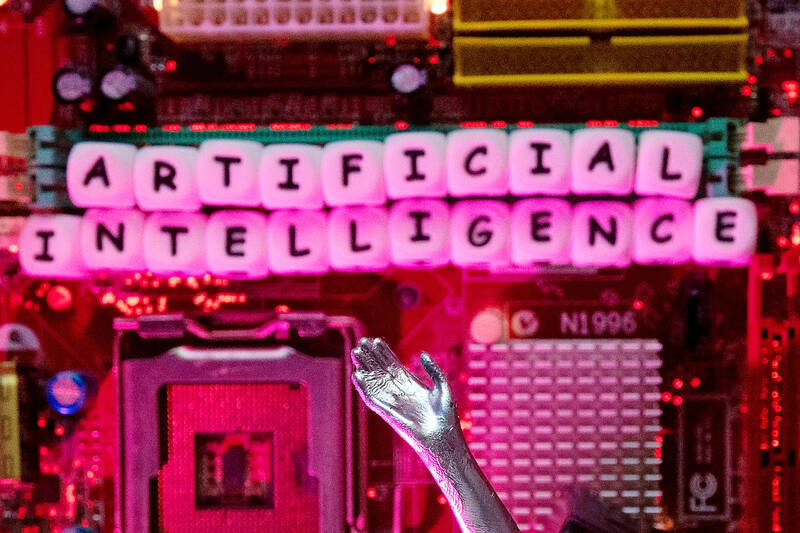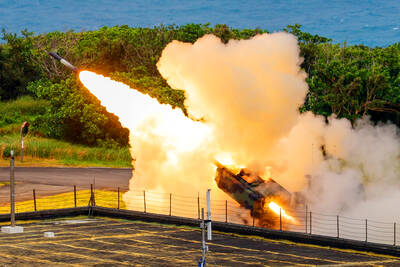Chinese researchers are exploring ways to use artificial intelligence (AI) tools such as ChatGPT to manipulate global audiences, possibly including their perceptions of Taiwan, a RAND Corp study found.
The US-based think tank published the report The Rise of Generative AI and the Coming Era of Social Media Manipulation 3.0 on Thursday last week discussing potential threats to US national security posed by actors misusing generative AI technologies, with a focus on China.
Although no evidence has shown that Beijing is using AI to generate and publish content on social media, it is the consensus among independent researchers and a number of governments that the Chinese government is conducting social media manipulation, the report said.

Photo: Reuters
“AI offers the CCP [Chinese Communist Party] the potential to fulfill longstanding desires to shape the global conversation about itself and China more broadly,” the report said.
It cited studies that pointed to Beijing’s attempt to interfere in Taiwan’s 2018 presidential election through social media manipulation.
New tactics emerged afterward, including using content farms to produce numerous false or misleading content, buying established Taiwanese social media accounts and allegedly paying Taiwanese influencers to spread pro-Beijing narratives, it said.
These efforts might not have a significant influence on election results, but seem to be “worsening Taiwanese political and social polarization and widening perceived generational divides,” it said.
Utilizing AI might further improve the authenticity of China-produced content, as well as reduce the money and the labor required to produce it, meaning it could reach further and wider, the report said.
With China’s technology ecosystem and strong government support, at least 30 Chinese companies, universities and research institutions were developing generative AI models as of April, it said.
By growing its technical capability in developing large language models, on which OpenAI’s ChatGPT is based, trained mainly on Chinese-language data, the Chinese government might acquire sufficient capability to conduct social media manipulation on both domestic and foreign scales, the report said.
Beijing’s efforts to shape foreign public opinion can be found on more than social media platforms, they also include print, radio and television, it said, adding that “using generative AI for such content at scale would be a natural progression of CCP efforts.”
Nathan Beauchamp-Mustafaga, one of the authors of the report, told Defense One on Thursday last week that “logically the next target for China would be the Taiwanese [2024 presidential] election” in terms of manipulating public opinion.
The Web site said that social media platforms “aren’t well positioned to guard against” China’s efforts to conduct large-scale manipulation using generative AI.

Authorities have detained three former Taiwan Semiconductor Manufacturing Co (TMSC, 台積電) employees on suspicion of compromising classified technology used in making 2-nanometer chips, the Taiwan High Prosecutors’ Office said yesterday. Prosecutors are holding a former TSMC engineer surnamed Chen (陳) and two recently sacked TSMC engineers, including one person surnamed Wu (吳) in detention with restricted communication, following an investigation launched on July 25, a statement said. The announcement came a day after Nikkei Asia reported on the technology theft in an exclusive story, saying TSMC had fired two workers for contravening data rules on advanced chipmaking technology. Two-nanometer wafers are the most

DEFENSE: The first set of three NASAMS that were previously purchased is expected to be delivered by the end of this year and deployed near the capital, sources said Taiwan plans to procure 28 more sets of M-142 High Mobility Artillery Rocket Systems (HIMARS), as well as nine additional sets of National Advanced Surface-to-Air Missile Systems (NASAMS), military sources said yesterday. Taiwan had previously purchased 29 HIMARS launchers from the US and received the first 11 last year. Once the planned purchases are completed and delivered, Taiwan would have 57 sets of HIMARS. The army has also increased the number of MGM-140 Army Tactical Missile Systems (ATACMS) purchased from 64 to 84, the sources added. Each HIMARS launch pod can carry six Guided Multiple Launch Rocket Systems, capable of

CHINA’s BULLYING: The former British prime minister said that he believes ‘Taiwan can and will’ protect its freedom and democracy, as its people are lovers of liberty Former British prime minister Boris Johnson yesterday said Western nations should have the courage to stand with and deepen their economic partnerships with Taiwan in the face of China’s intensified pressure. He made the remarks at the ninth Ketagalan Forum: 2025 Indo-Pacific Security Dialogue hosted by the Ministry of Foreign Affairs and the Prospect Foundation in Taipei. Johnson, who is visiting Taiwan for the first time, said he had seen Taiwan’s coastline on a screen on his indoor bicycle, but wanted to learn more about the nation, including its artificial intelligence (AI) development, the key technology of the 21st century. Calling himself an

South Korea yesterday said that it was removing loudspeakers used to blare K-pop and news reports to North Korea, as the new administration in Seoul tries to ease tensions with its bellicose neighbor. The nations, still technically at war, had already halted propaganda broadcasts along the demilitarized zone, Seoul’s military said in June after the election of South Korean President Lee Jae-myung. It said in June that Pyongyang stopped transmitting bizarre, unsettling noises along the border that had become a major nuisance for South Korean residents, a day after South Korea’s loudspeakers fell silent. “Starting today, the military has begun removing the loudspeakers,”